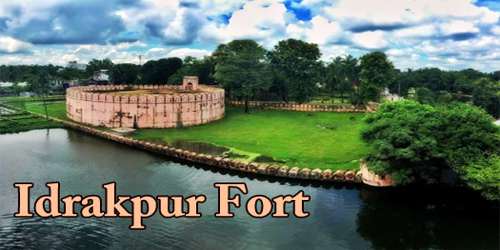Idrakpur Fort (Bengali: ইদ্রাকপুর কেল্লা) situated at Munshiganj proper, now on the west bank of the canal running through the town, and on the eastern vicinity of Deobhog village. The fort was built approximately in 1660 A.D. According to a number of historians, the river fort was built by Mir Jumla II, a Subahdar of Bengal under the Mughal Empire, to establish the control of the Mughal Empire in Munsiganj, and to defend Dhaka and Narayanganj from the pirates. The fort was a part of the triangular defense strategy for the vulnerable river route, from where the pirates used to attack Dhaka. The strategy was developed by Mir Jumla II with the help of the other two forts in Narayanganj- the Hajiganj Fort and the Sonakanda Fort.
The reason behind its construction was to protect Dhaka and Narayanganj from the Magh and Portuguese pirates. The subadar had an eagerness to establish the control of the Mughal Empire in Munsiganj as well. The fort was originally built on the bank of the junction of the river Meghna and Ichhamati as the Portuguese and Magh pirates used this point to enter Dhaka and to loot some cities like Sonargaon, Bikrampur(historic name of Munshiganj). According to the strategy of its construction, whenever the pirates made an approach to move forward Dhaka, the Mughal soldiers would be ordered to start firing mortars from the fort and the pirates had to retreat or die on the rivers.
Idrakpur river-fort is different from the other Mughal forts and has a number of unique features. The fort is apparently divided into two parts- the eastern part and the western part. The quadrangular eastern part and the polygonal western part combined into the complete fort. The brick-built fort comprises a wider open area surrounded by wall with bastions at the angles. The thick wall runs from north to south measuring 86.87-meter in length and 59.60-meter in width. The wall has machicolations from where the enemies on the river were targeted and the mortars were fired. There are a number of towers from where the movements of the enemies were observed. The most significant feature of the fort is the circular drum it has in the eastern part of the fort. The circular drum is further enclosed by another fortification wall, which was used for mounting huge cannons. The elevated circular drum of 32.5-meter in diameter and 9.14-meter high and can be reached by a staircase. The drum comprises three subsequent layers. Another remarkable feature of the fort is the existence of a staircase leading to a secret room at the foot of the drum. The staircase leads to a secret underground chamber which was the magazine or storehouse for arms and explosives. According to some myth, the staircase was a part of the secret tunnel linked with Lalbagh Fort. The main entrance gate of the fort is on the north with a high rectangular bastion crowned by machicolated merlons which served as a guard room. On the top of the drum of the fort is the residential quarters of the Deputy Commissioner (DC), and the fort itself now serves as the jail.
Buses take approximately (1.30-2.30) hours from Gulistan to reach Munshiganj Court Bus stand as Munshiganj is about 35km east from the Dhaka city. Idrakpur port is very near to the bus stand. Tourists can use launch also from Sadarghat Launch Terminal, Dhaka, Bangladesh.
















